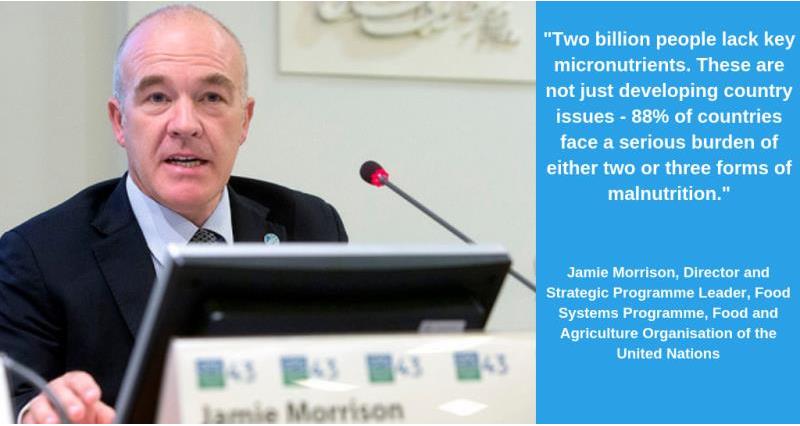Outward looking national food strategies: a moral imperative in an increasingly interconnected world
The way in which food is produced, transformed, delivered and consumed will be key in meeting a significant number of the Sustainable Development Goals that comprise the 2030 Agenda for Sustainable Development. Explicit in SDG 2 “End hunger, achieve food security and improved nutrition and promote sustainable agriculture”, the future development of food systems will also be central to achieving more sustainable consumption and production, generating adequate levels of employment and income in rural communities, and in ensuring the sustainable use of the natural resource base.
Although often considered as a somewhat remote, global, agenda, there are two key reasons why the 2030 Agenda must be integral to the development of national food strategies:
- The 2030 Agenda, presented as a universal challenge and collective responsibility of all countries, provides a vision for addressing inequalities within as well as among nations. This implies both national ownership of the agenda and intergovernmental accountability for its delivery.
- The SDGs focus attention on the relationships between and trade-offs among complex issues faced, albeit to differing degrees, by all countries. This is particularly pertinent to food strategies which need to address multiple and sometimes conflicting objectives. For example, improving efficiencies through increased productivity or reduced levels of food waste, while ensuring that more vulnerable producers, workers and consumers are not excluded from the benefits that these improvements may bring.
While the significant challenges in balancing such outcomes within a national strategy can result in an inward looking approach, the 2030 Agenda reinforces the need to take a more outward looking approach particularly in determining how the national food strategy of a more advanced country can inform and support the moral imperative of addressing critical global food related issues.
Global malnutrition statistics are stark and deteriorating: one in nine of the global population are undernourished (821m); 22% of children under the age of five are stunted (151m), 672 million adults are obese, with a further 1.4 billion adults and 40 million children under the age of five overweight. Two billion people lack key micronutrients. These are not just developing country issues – 88% of countries face a serious burden of either two or three of these forms of malnutrition.
Exacerbating the challenge of eliminating malnutrition are the growing pressures on food systems. The combination of population and income growth are projected to create a 50% increase in the global demand for food by 2050. This increase in demand will be uneven across countries and regions, often complicated by trends in urbanization which could see an additional 2.4 billion people living in towns and cities creating additional challenges in ensuring that sufficient quantities of nutritious and affordable food is available to urban dwellers. Concomitantly, the impacts of climate change with higher average temperatures, changes in precipitation, increasing frequency and intensity of damaging weather events, and increases in damage from pests and diseases are predicted to have a disproportionately negative impact on precisely those countries in which food demand is projected to grow most strongly.
As a result, an increase in trade is likely to be a central feature of future global food systems, but with trade patterns, which have tended to evolve in response to economic and demographic drivers, becoming more significantly affected by countries’ ability to produce. Combined with a significant shift towards more sustainable consumption and production, an increase in food trade would allow the projected increase in global food demand to be met with a less than proportionate increase in supply. This will, however, require a significant improvement in the coordination of actions across and within nations.
Three key contributions to addressing the challenges set out in the 2030 Agenda should be reflected in a new, outward looking food strategy for the UK:
- As a global exporter of quality food products, to contribute to the development of global food trade that doesn’t undermine local production and employment opportunities in trading partners or negatively affect the nutritional quality of their diets.
- As an innovator, to lead the drive towards more sustainable food systems, producing more and better quality food, generating improved returns to producers while putting less pressure on the natural resource environment.
- As a key global influencer, to support the strengthening of food system governance by (i) ensuring coherence across the international standards, trade agreements and voluntary guidelines which together provide the framework within which nations act; (ii) supporting improved national level intersectoral coordination; and (iii) capacitating food system actors to shape, and to take advantage of, fairer incentives to deliver greater quantities of more nutritious, safe and sustainably produced food.
This contribution is based on statistics and insights presented in several recent FAO publications:
FAO (2016) Trade and food security: achieving a better balance between national priorities and the collective good. The State of Agricultural Commodity Markets 2015-16 http://www.fao.org/publications/soco/the-state-of-agricultural-commodity-markets-2015-16/en/
FAO (2017) The future of food and agriculture: trends and challenges http://www.fao.org/3/a-i6583e.pdf
FAO (2018) The future of food and agriculture: alternative pathways to 2050 http://www.fao.org/3/I8429EN/i8429en.pdf
FAO (2018) Agricultural trade, climate change and food security. The State of Agricultural Commodity Markets 2018 http://www.fao.org/publications/soco/en/
FAO, IFAD, UNICEF, WFP, WHO (2018) Building climate resilience for food security and nutrition. The State of Food Security and Nutrition in the World. http://www.fao.org/3/I9553EN/i9553en.pdf
OECD-FAO (2018) Agricultural Outlook 2018 – 2017. http://www.fao.org/publications/oecd-fao-agricultural-outlook/2018-2027/en/
